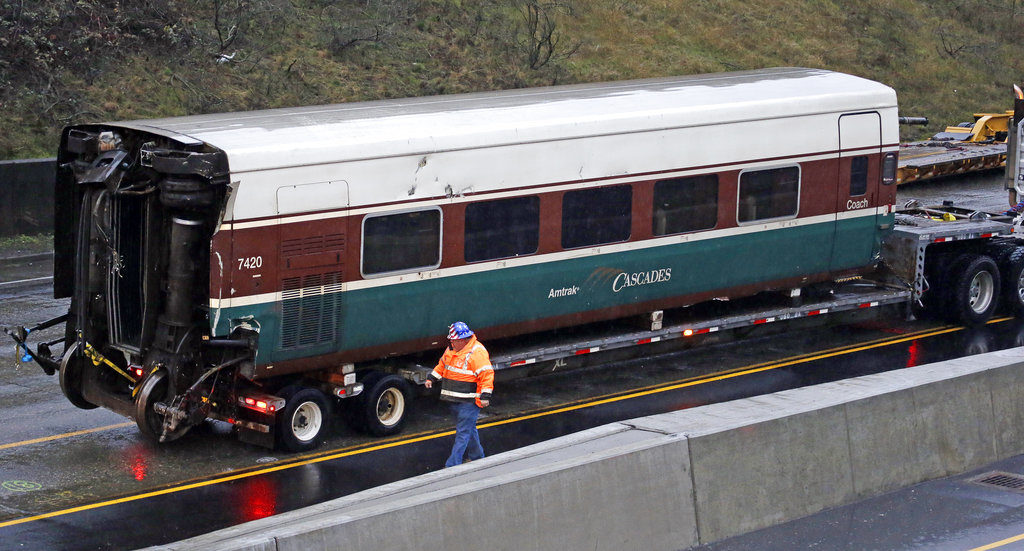WASHINGTON – A decade after Congress ordered the nation’s railroads to install an automatic braking system that could have prevented more that 130 train wrecks, industry officials said Thursday that most lines will need two more years to finish the job.
In the 10 years since the installation was mandated, there have been 47 people killed, 648 people injured, and more than $150 million in damage done in 22 train crashes that could have been prevented had the system been in place, according to data compiled by the National Transportation Safety Board.
“For 50 years now – half a century – NTSB has issued one recommendation after another on [automatic braking],” Rep. Peter DeFazio, D-Ore., said Thursday at a hearing before the House subcommittee on railroads. “I hear a lot about the cost and the complexity. Let’s talk about the lives that have been lost.”
Speaking directly to the railroads, DeFazio said: “We’re going to kill more people because you are not doing your job.”
Edward Hamberger, president of the Association of American Railroads, a trade group for the freight railroads, responded that the railroads have made substantial progress to install a complex system that he said will cost them $10 billion.
“Not only do you have to install it, you have to make sure it works,” Hamberger said. “All class 1 railroads will be fully implemented by 2020.”
Hamberger said the system would be operative on 56 percent of the required route miles by year’s end.
Though the NTSB long had recommended the system known as positive train control (PTC), Congress began to debate the need for it in 2008. In the midst of that debate, a head-on collision between a Metrolink commuter train and a Union Pacific freight in Chatsworth, Calif., killed 25 people and injured more than 100. When the NTSB said automatic braking would have prevented the crash, Congress passed legislation setting a Dec. 31, 2015, deadline for railroads to have the system up and running.
“The NTSB is extremely concerned about any further delay to this lifesaving technology,” testified NTSB Chairman Robert Sumwalt, who has been an active participant in several major train crash investigations. “From a safety perspective, that delay is unacceptable.”
Thursday’s hearing came after four train wrecks in the past two months, two of which investigators say could have been prevented if PTC had been operative. It also would have prevented the two deadliest crashes since Chatsworth: the 2013 crash of a Metro-North commuter train in the Bronx that killed four and injured 61, and the 2015 derailment of an Amtrak train in Philadelphia that killed eight and injured 185.
Railroads have been generous campaign contributors to members of Congress, giving them almost $64 million since 1990. More than $2.3 million of that has gone to current members of the House subcommittee on railroads.
With an open door to many lawmakers, the railroads were able to exert enormous pressure when that deadline neared in 2015, and the then-administrator of the Federal Railroad Administration, Sarah Feinberg, refusing to grant them an extension unless Congress acquiesced.
Congress did, voting to extend the deadline to 2018. It also said that if railroads had the required hardware installed, had trained workers and acquired radio spectrum, and had the system ready on 50 percent of the required lines, they could wait until the end of 2020 to flip the switch.
The most recent FRA report, released in September, showed that some major railroads – notably BNSF Railway – were well down the road to completion, while other major railroads, and some transit systems, were well behind. Union Pacific has equipped a fraction of its trains, the FRA report said.
Overall, the FRA said, eight of the 37 railroads required to install the systems had fully complied with the congressional mandate.
“There are some that have put PTC in place,” subcommittee Chairman Jeff Denham, R-Calif., said. “There are others who haven’t started. This has gone on for 10 years. Ignoring a congressional mandate will not be tolerated. I think the American public is sick of excuses.”
Some transit agencies, which count on passenger fares and government subsidies, are among those furthest behind in meeting the deadline, the FRA report said. While a number of them, including the Southeastern Pennsylvania Transportation Authority (SEPTA) and Denver’s regional transit system are in full compliance, others, such as Maryland’s MARC line, the Long Island Rail Road and New Jersey Transit appear well short of meeting the deadline.
Paul Skoutelas, president of the American Public Transit Association, told the subcommittee that commuter rail lines must make a $4 billion investment in PTC, and that it will cost between $80 million and $130 million for transit systems to operate the system.
“This is a staggering number,” Skoutelas said, asking that Congress provide additional funding for transit.
The railroads have invested billions in the complex PTC system, which requires equipment more than 20,000 locomotives and installation of 24,000 interface units beside the rail bed to communicate with the train’s engineers.



